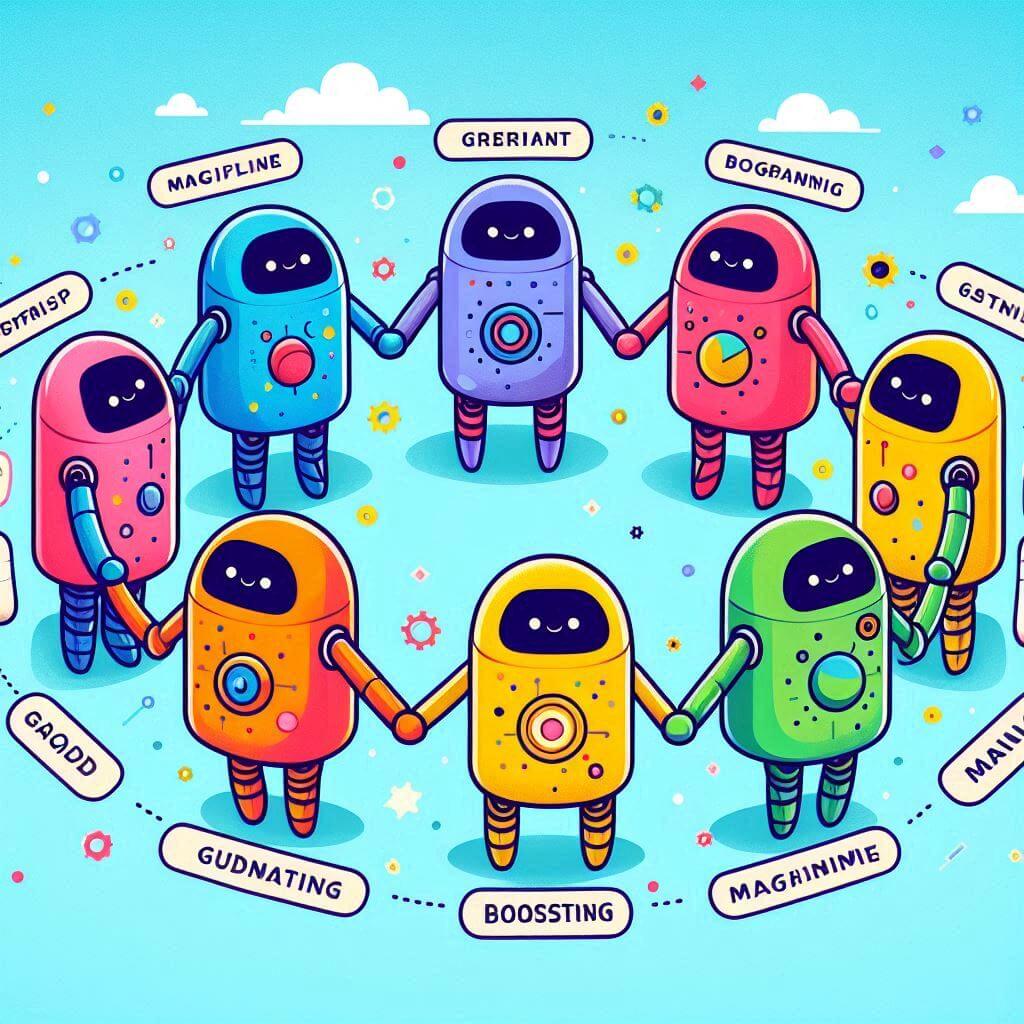Augmentation is a fundamental concept in machine learning that revolves around the idea of turning weak models into strong models. This is achieved through a process where multiple models are trained sequentially, each new model focusing on the mistakes made by the previous ones. In the context of gradient boosting machines (GBMs), boosting usually involves learning decision trees one at a time. Each tree is constructed to minimize residual errors, which are the differences between actual and predicted values. This sequential training allows GBM to give more weight to cases where previous models made mistakes, thereby honing the model’s accuracy over iterations.
The roots of boosting lie in the AdaBoost algorithm, introduced by Freund and Shapir in the 1990s. AdaBoost works by adjusting the weights of misclassified instances in each training iteration, making the model focus more on difficult cases. This principle has been extended in Gradient Boosting, where the idea is to optimize the model by minimizing the differential loss function using gradient descent. Gradient descent helps to find the optimal parameters for the model by iteratively moving towards the minimum of the loss function, thereby improving the model predictions.
GBMs further improve this concept by allowing flexible optimization of different objective functions. This means that, unlike traditional boosting methods, which can only focus on simple classification tasks, GBM can be adapted for regression tasks and other more complex purposes. For example, in regression problems, the model minimizes the mean squared error (MSE) between the predicted and actual values. In classification problems, it optimizes the logarithmic loss, which is a measure of accuracy.
 The process involves three main steps in each iteration: fitting the model to the negative gradient of the loss function for the predictions of the current model, updating the model, and then combining the old model with the new model. These steps are repeated for a certain number of iterations or until the performance of the model stops improving.
The process involves three main steps in each iteration: fitting the model to the negative gradient of the loss function for the predictions of the current model, updating the model, and then combining the old model with the new model. These steps are repeated for a certain number of iterations or until the performance of the model stops improving.
GBM uses a concept called reduction or learning rate, which scales the contribution of each tree. A lower learning rate can significantly improve model performance by making the reinforcement process more gradual and therefore less prone to overfitting, although at the cost of requiring more iterations for convergence. Regularization techniques such as subtree reduction, limiting the maximum depth of individual trees, and introducing stochastic features (eg, sampling a subset of data or features) are also used to improve model generalization.
Implementation In Modern Data Science
Modern implementations of Gradient Boosting Machines (GBM), such as XGBoost, LightGBM, and CatBoost, have revolutionized the application of these models in data science. Each of these implementations offers unique features and optimizations that make them suitable for different tasks and datasets.
XGBoost, which stands for eXtreme Gradient Boosting, is one of the most popular versions of GBM. It excels in speed and performance due to the efficient handling of sparse data using a technique called Sparity Aware Split Finding. XGBoost also includes several regularization terms in its objective function, which helps prevent overfitting. In addition, it supports parallelized tree construction, which significantly speeds up the learning process on multi-core machines. This implementation is particularly noted for its high predictive power and ability to handle a wide range of loss functions, making it versatile for both classification and regression tasks.
LightGBM, developed by Microsoft, provides additional efficiency by using the gradient-based one-way sampling (GOSS) technique. GOSS prioritizes instances with larger gradients, thus reducing the number of data points needed to train each tree without sacrificing accuracy. Another innovation in LightGBM is exclusive function pooling (EFB), which combines mutually exclusive functions—those that rarely have non-zero values at the same time—into a single function to save memory and computational cost. These techniques make LightGBM extremely fast and memory efficient, making it a better choice for very large datasets with high-dimensional feature spaces.
CatBoost from Yandex specializes in efficient processing of categorical features. Traditional GBM implementations require preprocessing these features into numerical values using techniques such as one-shot coding, which can be inefficient and impractical for datasets with high cardinality categorical variables. CatBoost solves this by implementing ordered boosting and a sophisticated categorical feature processing method that allows native and efficient processing of categorical data. In addition, CatBoost offers out-of-the-box support for missing values and provides tools to improve model interpretation, such as feature importance estimation.
These modern implementations also include robust tools for tuning hyperparameters, which is crucial for optimizing model performance. Parameters such as learning rate, number of estimators, maximum tree depth, and subsampling frequency can be fine-tuned using methods such as grid search and random search. More advanced techniques such as Bayesian optimization are also supported to intelligently navigate the hyperparameter space and find the most efficient model configurations with fewer iterations.
In addition, these GBM libraries are designed to be highly compatible with popular data science ecosystems such as Python and R. They offer extensive APIs and integration capabilities that allow them to be seamlessly incorporated into machine learning workflows. This compatibility extends to integration with other machine learning libraries such as Scikit-learn, allowing data scientists to build and evaluate complex pipelines with relative ease.
The ability of these implementations to handle large data sets, volumetric functions, and various objective functions, combined with their computational efficiency, have made them indispensable tools in competitive machine-learning tasks. They often take top positions in machine learning competitions held on platforms such as Kaggle, highlighting their effectiveness in real-world data science applications.
Main Programs And Benefits
Due to their high precision and flexibility, gradient amplification machines (GBMs) offer a wide range of applications in various fields. One of the most prominent areas in which GBM excels is in finance. In the financial markets, Gradient Boosting is widely used to predict stock prices. Models like XGBoost can handle complex nonlinear relationships in historical market data, improving the quality of stock price predictions. In addition, the GBM credit rating is used to assess the creditworthiness of individuals. They analyze historical data about borrowers to predict the likelihood of default, thus helping in loan approval decisions. In addition, GBMs play an important role in fraud detection by identifying unusual patterns and anomalies in transaction data, and flagging potential fraud cases for further investigation.
In the healthcare sector, GBMs have become invaluable for predictive analytics. For example, they are used to predict patient outcomes based on historical patient data, which includes a variety of characteristics such as age, medical history, laboratory results, and treatment plans. This helps identify high-risk patients and develop individualized treatment plans in advance. GBMs are also used to diagnose diseases; by learning from vast datasets of patient symptoms and diagnostic outcomes, they can aid in early and accurate disease detection, leading to better patient outcomes.
Marketers use GBM for customer segmentation and sales forecasting. For example, they analyze buying patterns and customer demographics to effectively segment the customer base. This segmentation allows you to apply targeted marketing strategies, thereby increasing the chances of converting leads into sales. In sales forecasting, GBMs analyze historical sales data and external factors such as seasonality and market trends to accurately predict future sales, allowing companies to make informed inventory and staffing decisions.
GBMs excel at handling structured data, making them particularly effective in applications such as recommender systems. For example, on e-commerce platforms, GBMs analyze user behavior, purchase history, and product characteristics to recommend products that users are likely to purchase. This improves user experience and increases sales.
Another important advantage of GBMs is their ability to automatically handle missing values in datasets. Unlike some other machine learning methods that require extensive data preprocessing to fill in or impute missing values, GBMs can directly manage these gaps by optimizing the data preparation process. This feature is especially useful in real-world scenarios where collecting complete data can be challenging.
The robustness of GBMs in capturing complex interactions between features without extensive feature development is another of their strengths. They can detect and model nonlinear dependencies and interactions between variables that are often missed by simpler models. This capability provides more accurate and reliable forecasts.
Automated feature importance ranking provided by GBMs helps in selecting features and understanding the contribution of each feature to the final model output. By knowing which features are most influential, data scientists can make more informed decisions about what data to collect and how to further improve model performance.
Although computationally intensive, the scalability of modern GBM implementations allows them to efficiently process very large datasets. In big data applications where the volume, velocity and variety of data are high, GBM’s ability to scale data is critical. Techniques such as distributed computing implemented in libraries such as XGBoost and LightGBM allow GBM to be deployed on large-scale data with minimal bottlenecks.
